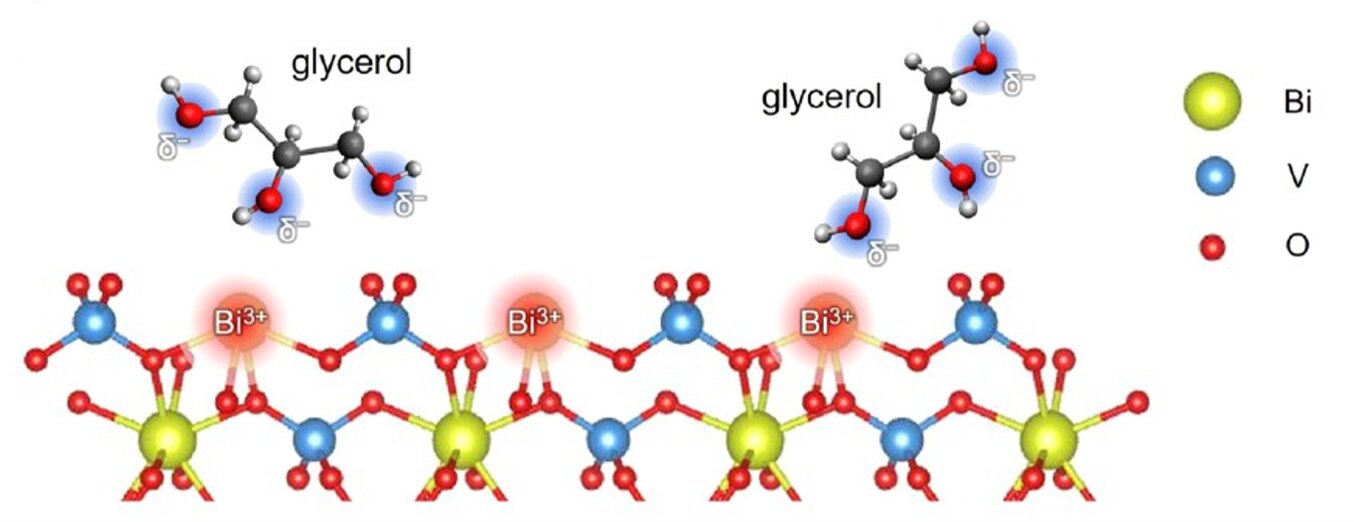The right electrolytes can improve glycerol oxidation


The hydroxyl groups of the glycerin are attracted to the Bi3+ Ions on the surface of BiVO4 Photoanode. The electrolyte plays a crucial role in mediating these interactions. Image credit: HZB
In 2023, around 16 billion liters of biodiesel and HVO diesel were produced in the European Union, based on corn, rapeseed or partly on residues from agricultural production. A byproduct of biodiesel production is glycerol, which can be used as a building block for the production of valuable chemicals such as dihydroxyacetone, formic acid, glyceraldehyde and glycolaldehyde via a glycerol oxidation reaction (GOR). Glycerol can be electrochemically oxidized in (photo)electrochemical (PEC) reactors, which are currently being developed specifically for the production of green hydrogen.
However, this route is currently little used in PEC plants, although it could significantly increase the economic efficiency of the PEC Power-to-X process, since the oxidation of glycerin requires significantly less energy compared to hydrogen production by water splitting, but at the same time produces more valuable chemicals.
Investigate the influence of different electrolytes
Many studies have already examined the role of photocatalysts in PEC electrolyzers, but the role of the electrolyte has not yet been systematically analyzed. A team led by Dr. Marco Favaro at the Institute for Solar Fuels has now revealed the influence of the electrolyte composition on the efficiency and stability of glycerol oxidation.
The team’s article was published in the journal Chemical Science.
They used a PEC cell with photoanodes made of nanoporous bismuth vanadate (BiVO4). They tested acidic electrolytes (pH = 2) with various cations and anions, including sodium nitrate (NaNO3), sodium perchlorate (NaClO4), sodium sulfate (Na2SO4), potassium sulfate (K2SO4) and potassium phosphate (KPI).
“Our results showed that BiVO4 Photoanodes achieve the best performance in NaNO3 and exceed the commonly used Na2SO4 in terms of photocurrent, stability and production rates of high-quality glycerol oxidation reaction products,” summarizes Favaro.
Sodium nitrate is most effective
The team also investigated the reasons for this difference in performance. Their hypothesis is that the size of the ions, their different salting-in and salting-out abilities (Hofmeister series) and their different pH buffering capacity play a role.
“The composition of the electrolyte has a surprisingly significant influence on the efficiency of glycerol oxidation, and we observed this trend in both bismuth vanadate and polycrystalline platinum anodes,” says PhD student Heejung Kong. This supports the idea that these findings could be generally applicable to different materials and processes.
Therefore, the choice of electrolyte is of great importance for the efficiency and stability of glycerol oxidation.
“Our research could help convert biomass byproducts into valuable chemicals more efficiently and produce valuable chemicals from waste materials while minimizing the impact on the environment,” says Favaro.
More information:
Heejung Kong et al, Electrolyte selection for efficient photoelectrochemical glycerol oxidation on BiVO4, Chemical Science (2024). DOI: 10.1039/D4SC01651C
Provided by the Helmholtz Association of German Research Centres
Quote: From waste to value: The right electrolytes can improve glycerol oxidation (July 1, 2024), accessed July 1, 2024 from https://phys.org/news/2024-07-electrolytes-glycerol-oxidation.html
This document is subject to copyright. Except for the purposes of private study or research, no part of it may be reproduced without written permission. The contents are for information purposes only.



